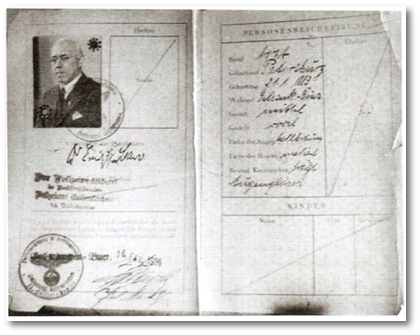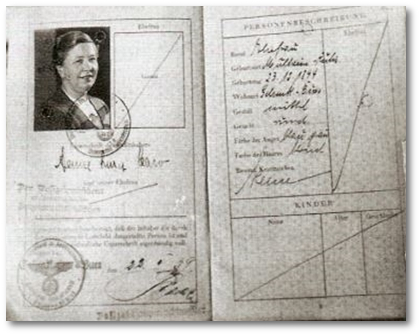
Fig. 1: passport Dr. Erich Caro, issued on 8th February, 1939 by the Chief of Police Recklinghausen, police office of Gelsenkirchen
Dr. Erich Oswald Caro, born on 21st January, 1883 in Petersburg/Russia, son of Jewish parents, had been living in Gelsenkirchen since 1918/19 and not later than by the 20s in Gladbecker Straße 12 (today: Buer-Gladbecker Straße). Having studied medicine in Berlin, he soon opened his own surgery. We do not know anything about the circumstances why he opted for Buer.
Dr. Caro's first wife Anna née Lehner died on 25th May, 1935. Their son Claus was born on 24th October, 1921. In February 1938 Dr. Caro married Anna (called Anne) Ladwig. According to the Nazi vocabulary and linguistic usage she was a „half-Jew“. Anna was born in Lemberg/Upper Palatinate on 7th April, 1887 and according to records in the registration office she moved to Gelsenkirchen in December, 1920.
|

Fig.2: passport Anna Caro, issued on 8th February, 1939 by the Chief of Police Recklinghausen, police office of Gelsenkirchen. Both passports show the identification „J“, and both are duly endorsed by the mandatory forenames „Israel“ and „Sara“ that had to be added to the first names of Jews, depending on gender, following the decree coming into effect since of 01st January, 1939.
But also Dr. Caro, who had for so many years been acknowledged and respected among the inhabitants of Buer, was forced to face up to the gradual deprivation of rights of the Jewish population. Whereas since 1933 he was initially only permitted to medicate Jewish patients, his approbation ceased in October 1938, and thus the licence to practise medicine terminated. Like him, his jewish colleagues had to face the same restriction: according to the city chronicle of Gelsenkirchen dated 13th October, 1938, out of the 13 doctors who had been registered beginning of 1933 and who had been practising during the investigation period , „ a considerable part had disappeared voluntarily“ by 1938. At that time, the German Jews had already been degraded to a status of an exploited minority, completely deprived of their rights. Under the impression of the development of the increasingly terroristic willpower of the NS regime and pressurized by the Gestapo, the family of Dr. Erich Caro fled to the Netherlands on 9th of May, in order to embark for the United States.
The Caros had to leave surgery and all their property behind them, they could just take the most necessary belongings with them. Unfortunately the German attack against the Netherlands impeded their plans so that the Caros could not reach their actual emigration destination, but instead the transit country became their exile country. Even more, the emigrants' ship „Veendam“ in the port of Rotterdam caught fire on the attack of the German troops, and with it, all belongings of the Caro family that had been taken onto the ship were burnt.
|
With the aid from the Dutch Resistance Movement the Caros – meanwhile completely penniless and destitute – could be accommodated in spring 1940 on a farm in the community of Loosdrecht, where they could hide for the duration of the war in narrow circumstances. „They lived there hidden from the outside world – isolated in a sort of barn on a farm situated between the two villages Nieuwsluis and Loenen in the Dutch province of Utrecht.“ Shortly after the Nazi Germans having invaded the Netherlands all Jewish residents were ordered to get themselves registered. As Caro later on said, he was „fully aware of the intention of the German measures and he recognized immediately the danger they implied“. Consequently, he procured „with the aid of the town mayor in charge in Loosdrecht and by means of misleading statements towards the Dutch-German authorities in Den Haag regarding our personal details Dutch identity cards which would protect us.“ By means of the Dutch papers he and his wife succeeded in identifying themselves as „living in a mixed marriage“ and thus evade deportation.
„I consistently ignored and refused all requests and even threats from Amsterdam to have ourselves registered. I was fully aware of the fact that if Gestapo would see through the game I „played“, they would arrest me immediately and send me to a penal concentration camp, and my family, too would be lost – but taking the risk was the only chance that I saw to evade the fate waiting for all the Jews who had followed the request and had themselves registered. There was no illusion about that.“ So the Caros lived with the permanent threat of being discovered hence why they tried to show up in public as little as possible. Erich Caro did not go out at all for the duration of more than 12 months, as „traitors, snitches and collaborators were enough and to spare among the Dutch population“...
Despite all caution, Anna Caro was among the first to receive the written request sent by Gestapo to report to the administration in Utrecht for joining the deportation transport to Poland in summer 1942. Erich Caro succeeded in convincing the mayor that this letter must be based on an error in the interpretation of the regulations. After several negotiations he managed to get a passport for his wife without a „J“. With this document she went to the Gestapo headquarters in Amsterdam and succeeded to walk away free on the basis of this passport without the „J“ . In addition to all the above, controls in Loosdrecht were handled quite sporadically, consequently the family was safe from arresting measures up to 1945, so that they survived persecution, deportation and the murder of the Jews in the Netherlands. In the second half of 1945 Dr. Caro returned to Gelsenkirchen-Buer and re-opened his surgery. His wife followed him in January, 194
Until the 1970s the couple lived in Buer, at the same address as prior to their escape: in Buer-Gladbecker Straße 12. Their son Klaus emigrated to the United States. Since 1949 the couple fought for their recognition as „racially pursued persons“ and in 1954 they handed in their application to the Reparation Office in Gelsenkirchen (dealing with indemnification claims from victims of NS Germany) according to the „federal law of compensation of 1953 concerning „damage of freedom, body and sanity“, „impediment of professional and economical career“ as well as damage of „property and asset. By the end of the 50s, their motion concerning the status of being „victims of racial persecution“ was approved, the request of a reparation payment for the „damage of freedom“ (suffered during their illegal life in the Netherlands) was refused, though!
|